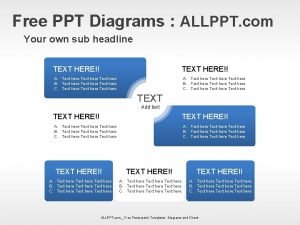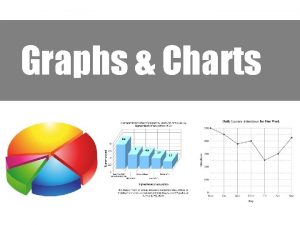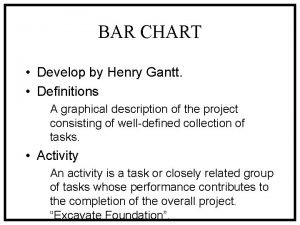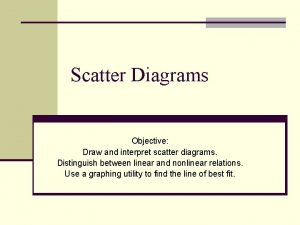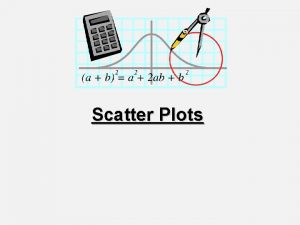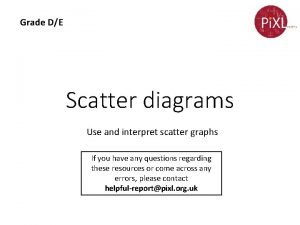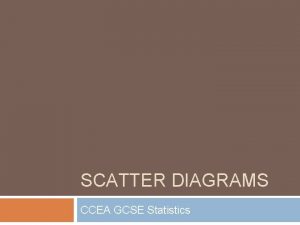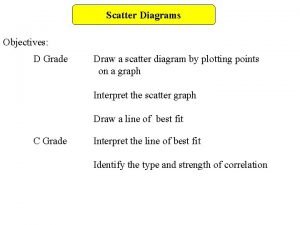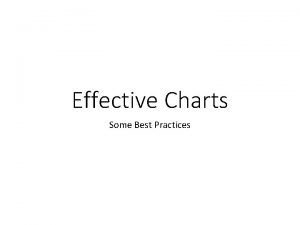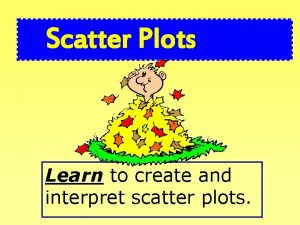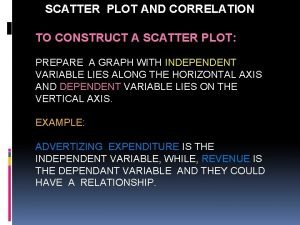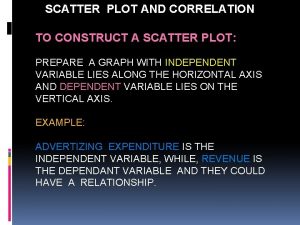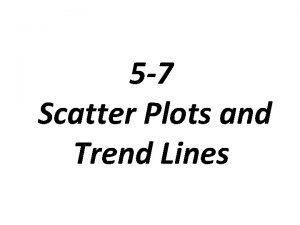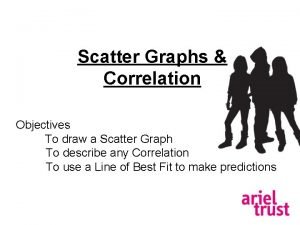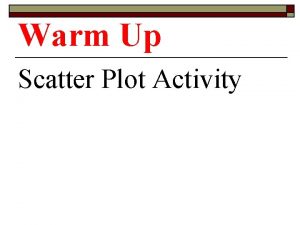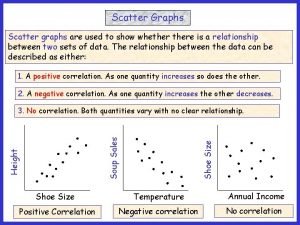SCATTER DIAGRAMS AND SOME CHARTS Content Scatter diagrams























- Slides: 23

SCATTER DIAGRAMS AND SOME CHARTS Content • Scatter diagrams • Some charts – Pie charts – Bar charts – Line charts 1

SCATTTER DIAGRAMS • Often, we are interested in two variables. For example, we may want to know the relationship between – advertising and sales – experience and time required to produce an unit of a product 2

SCATTTER DIAGRAMS • Scatter diagrams show two variables are related to one another – To draw a scatter diagram, we need a set of two variables – Label one variable x and the other y – Each pair of values of x and y constitute a point on the graph 3

SCATTTER DIAGRAMS • In some cases, the value of one variable may depend on the value of the other variable. For example, – sales depend on advertising – time required to produce an item of a product depend on the number of units produced before • In such cases, the first variable is called dependent variable and the second variable is called independent variable. For example, Independent variable Dependent variable Advertising Sales Number of units produced Production time/unit 4

SCATTTER DIAGRAMS • Usually, independent variable is plotted on the horizontal axis (x axis) and the dependent variable on the vertical axis (y axis) • Sometimes, two variables show some relationships – positive relationship: two variables move together i. e. , one variable increases (or decreases) whenever the other increases (or, decreases). Example: advertising and sales. – negative relationship: one variable increases (or, decreases) whenever the other decreases (increases). Example: number of units produced and production time/unit 5

SCATTTER DIAGRAMS • Relationship between two variables may be linear or non-linear. For example, – the relationship between advertising and sales may be linear. – the relationship between number of units produced and the production time/unit may be nonlinear. 6

SCATTTER DIAGRAMS (EXAMPLE) 7

8

SCATTTER DIAGRAMS (EXAMPLE) 9

10

PIE CHARTS • A pie chart is the most popular graphical method for summarizing quantitative/nominal data • A pie chart is a circle is subdivided into a number of slices • Each slice represents a category • Angle allocated to a slice is proportional to the proportion of times the corresponding category is observed • Since the entire circle corresponds to 3600, every 1% of the observations corresponds to 0. 01 3600 = 3. 60 11

PIE CHARTS (EXAMPLE) 12

13

BAR CHARTS • Bar charts graphically represent the frequency or relative frequency of each category as a bar rising vertically • The height of each bar is proportional to the frequency or the relative frequency • All the bars must have the same width • A space may be left between bars • Bar charts may be used for qualitative data or categories that should be presented in a particular order such as years 1995, 1996, 1997, . . . 14

BAR CHARTS (EXAMPLE) 15

16

LINE CHARTS • Line charts are often used when the categories are points in time. Such a chart is called a time-series chart. For example, consider a graph that shows monthly or weekly sales data. • Frequency of each category is represented by a point above and then points are joined by straight lines 17

LINE CHARTS (EXAMPLE) 18

19

20

CHOICE OF A CHART • Pie chart – Small / intermediate number of categories – Cannot show order of categories – Emphasizes relative values e. g. , frequencies • Bar chart – Small / intermediate/large number of categories – Can present categories in a particular order, if any – Emphasizes relative values e. g. , frequencies 21

CHOICE OF A CHART • Bar chart – Small/intermediate/large number of categories – Can present categories in a particular order, if any – Emphasizes relative values e. g. , frequencies • Line chart – Small/intermediate/large number of categories – Can present categories in a particular order, if any – Emphasizes trend, if any 22

EFFECTIVE USE OF GRAPHICAL TECHNIQUES 1. Tables may be used for small data sets and graphs for large data sets 2. A graph must convey an idea or a concept 3. If a graph shows two or more variables, the relationship between the variables must be clearly described 4. A graph must emphasize fact, not color, picture or other form of the graph 5. A graph must not distort facts 23
 Allppt.com free
Allppt.com free Free templates power point
Free templates power point Allppt.com.
Allppt.com. Allppts
Allppts Www allppt
Www allppt Carrier content vs real content
Carrier content vs real content Static content vs dynamic content
Static content vs dynamic content What is contact force
What is contact force Some trust in chariots and some in horses song
Some trust in chariots and some in horses song The interaction diagrams, use case diagrams are called as
The interaction diagrams, use case diagrams are called as Rake symbol in activity diagram
Rake symbol in activity diagram They say sometimes you win some
They say sometimes you win some God when you choose to leave mountains unmovable
God when you choose to leave mountains unmovable Sweets countable or uncountable noun
Sweets countable or uncountable noun Some say the world will end in fire some say in ice
Some say the world will end in fire some say in ice Some say the world will end in fire some say in ice
Some say the world will end in fire some say in ice How to calculate fluid intake and output
How to calculate fluid intake and output Graphs and charts
Graphs and charts Bar graphs advantages and disadvantages
Bar graphs advantages and disadvantages Jackson and moreland alignment charts
Jackson and moreland alignment charts Notice and note anchor charts
Notice and note anchor charts Composite bar charts worksheet
Composite bar charts worksheet Describing graphs examples
Describing graphs examples Notice and note anchor charts
Notice and note anchor charts




